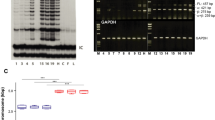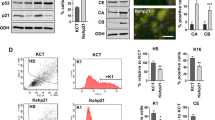Abstract
Around 60% of oral squamous cell carcinomas (SCCs) have been shown to harbour p53 mutations, and other studies have demonstrated mutant p53 genes in normal and dysplastic squamous epithelium adjacent to these SCCs. In line with these earlier studies we show here that DOK, a keratinocyte cell line derived from a dysplasia, displays elevated levels of p53 protein and harbours a 12 bp in-frame deletion of the p53 gene spanning codons 188-191. In contrast, the coding region of the p53 gene was normal in a series of six benign recurrent laryngeal papillomas and a series of four premalignant oral erythroplakia biopsies and their cell cultures. All but one of these lesions were free of malignancy at the time of biopsy, in contrast to the premalignant lesions studied by previous investigators, but keratinocytes cultured from these lesions all displayed a partially transformed phenotype that was less pronounced than that of DOK. Since three out of four of the erythroplakia patients developed SCC within 1 year of biopsy, these lesions were by definition premalignant. The availability of strains of partially transformed keratinocytes from premalignant erythroplakias which possess normal p53 genes should enable us to test the role of mutant p53 in the progression of erythroplakia to SCC. The premalignant tissues and cultures were also tested for the presence of human papillomavirus (HPV), which is known to inactivate p53 function in some cases. Only the benign papillomas were shown to contain high levels of either HPV 6 or HPV 11 E6 DNA, but not both, and none of the samples contained detectable levels of HPV 16, HPV 18 or HPV 33 E6 DNA or L1 DNA of several other HPV types. There was therefore no evidence to suggest that p53 was being inactivated by a highly oncogenic HPV in these samples.
This is a preview of subscription content, access via your institution
Access options
Subscribe to this journal
Receive 24 print issues and online access
$259.00 per year
only $10.79 per issue
Buy this article
- Purchase on Springer Link
- Instant access to full article PDF
Prices may be subject to local taxes which are calculated during checkout
Similar content being viewed by others
Author information
Authors and Affiliations
Rights and permissions
About this article
Cite this article
Burns, J., Clark, L., Yeudall, W. et al. The p53 status of cultured human premalignant oral keratinocytes. Br J Cancer 70, 591–595 (1994). https://doi.org/10.1038/bjc.1994.356
Issue Date:
DOI: https://doi.org/10.1038/bjc.1994.356
This article is cited by
-
Oral lichen planus: a microbiologist point of view
International Microbiology (2021)
-
Profiling early head and neck cancer
Nature Reviews Cancer (2005)
-
Cell, tissue and organ culture as in vitro models to study the biology of squamous cell carcinomas of the head and neck
Cancer and Metastasis Review (1996)



